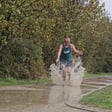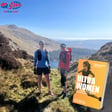Introduction to David Potach's Expertise
00:00:00
Speaker
Welcome to the UK sports podcast. I'm Joe Williams and today I welcome David Potash. David is a sports physical therapist. He is author of Sport Injury Prevention Anatomy.
00:00:14
Speaker
This book is a science-based overview of common sport injuries and it contains exercise interventions to reduce injury risk. David was a strength and conditioning coach at Creighton University for several years, which afforded him the opportunity to work with not only high-level college athletes, but for all sports, but also professional and Olympic athletes.
00:00:37
Speaker
He was honored as one of the first recipients of the NSCA's Sports Medicine Professional of the Year award in 2005. That is the National Strength and Conditioning Association. That's a non-profit organization in the US.
Focus on Injury Prevention for Runners
00:00:52
Speaker
Today we are going to be speaking about injury prevention for runners.
00:00:57
Speaker
do enjoy the podcast. We will be recording more in the lead up to Christmas, so look out for our next episode in the next week or so. Any questions or comments, you're welcome to get in touch. Email is info at ukrunchat.co.uk. Enjoy. Welcome, David. Thanks for coming on the UK Run Chat podcast.
00:01:20
Speaker
Thank you so much. I'm super excited to be here and chat about running and how to prevent injuries. So thank you so much for the invitation and opportunity. Would you like to give us a little bit of an introduction to yourself? Of course. I'm a physical therapist physio for those in the UK. And I've been doing this for 20 some years. Prior to being a physical therapist, I was a strength and conditioning coach for a major university in the United States.
00:01:49
Speaker
So I have a long history of working with athletes, helping them to improve their sporting performance, running performance, and so on. I eventually changed that to more of a rehab and injury prevention focus. So that's really what I've been doing for the past 20 some years is that injury prevention and rehab focus primarily with athletes.
From Soccer to Marathons: David's Athletic Journey
00:02:17
Speaker
Are you a runner yourself David or what's your sport of choice?
00:02:22
Speaker
Well, I started off life as a soccer player, football for those over there. I do know that Chelsea just fired their manager and that's my favorite Premier League team. Interesting timing today having this interview. So I started off life as a soccer fan and still enjoy it. Chelsea, Barcelona, my son is a Manchester United fan, my other son is an Everton fan.
00:02:47
Speaker
We've got fans all over the UK, but eventually transitioned to running. I decided in 2004 that I wanted to run a marathon and I chose the Chicago Marathon.
00:02:58
Speaker
Back then it was easier to get into, now it's lottery based. So that was my very first race, was the 2004 Chicago Marathon. Hadn't done anything prior to that, no 10K, half marathon, and so on. And since then I've continued to run, ran 20 miles this past weekend, I think 32K for those over in the UK. So that's really what I do. I run five, six, seven days a week.
00:03:23
Speaker
That's how we stayed fit and active. Thank you for translating. We have many different measurements over in the UK for different things. Fair enough, yes. So how did the interest in Chelsea come about then? I'm sorry, what? How did the interest in Chelsea specifically as a football team to support come about?
00:03:45
Speaker
Yeah, it's a unique choice. I mean, most people here of Manchester United, especially Arsenal as well. But I had a patient who went on to play college soccer and she won a national championship with Notre Dame 15 or so years ago. She was a Chelsea fan. I didn't really have a dog in the fight, so to speak. Didn't really have a team that I followed. So because of her interests, it was pretty intense interest back then.
00:04:11
Speaker
I started to follow them, and I've stuck with them through good and bad times and excellent times here recently. I've stuck with them, and yes, having a US player, Christian Polisic, on the team doesn't hurt. Although he's not been playing very much lately. He should be. He's excellent. He's very, very good. I enjoy watching him play. His motor just never stops, so it's fascinating to watch him. It's fun to watch.
00:04:39
Speaker
Yeah, I actually thought one of the other big clubs might come in for him because he hadn't been a first choice because he's a very, very good player. And your children support Everton and Manchester United, so there's some divided loyalties.
00:04:55
Speaker
There is and there's good-natured ribbing my my youngest son is 15 and he's the man you fan and He's been having a really rough go of it over the past few years. So my oldest son who's 22 definitely needles him and Teases him quite a bit about it. Yeah. Yeah, very good. Well, we're the same in my household. We have some wheels important
00:05:19
Speaker
Good fun coming from that. So you just went for it then with your running, just 2004. I'm not going to do a thank you.
Powerlifting to Running: Overcoming Injury and Transitioning Sports
00:05:28
Speaker
I'm just going to go for a marathon. What was the thinking behind that then? I don't really know, to be honest with you, Joe. Prior to that, I was a strength athlete. I was into powerlifting, lifting heavy weights. I'm not a big person, but I was able to put up a lot of weight.
00:05:48
Speaker
I had a back injury, which kind of curtailed that. And eventually I said, what else is there to do? And had these patients who were runners, followed the New York Marathon online. It was televised. So I decided, well, let's try a marathon. And so I did the Chicago, as I mentioned, and did New York the next year, 2005. I'm not fast, but I do enjoy running. And surprisingly,
00:06:18
Speaker
over the past, what is it, 18 years or so that I've been running, I've actually gotten faster. I'm in my fifties now, early fifties, and I run faster now than I did back in 2004. And a lot of that is really due to, yes, consistency over time, but it's having, I guess, a comprehensive plan to help keep me as injury-free as possible, because I haven't had very many injuries.
00:06:46
Speaker
part of that strength training, of course, but being smart about the way I progress and so on. So it's been fun to use some of what I know from a professional standpoint and apply it to my own personal interest in running. Yes. I have one friend who's a power lifter. So he's a strong man of events. He was 20-odd stone. I'm not sure how many pounds that is, sorry, but he's a big boy.
00:07:15
Speaker
When I was doing one of my long distance runs, he was pushing me to do more strength work than I did, which a lot of runners should do. And he put it to me that running is strength in motion, and I'd never really thought of it like that before. Well, it really is. And if you look at some of the top runners, Kip Chogy, Mo Farah from the UK, they all lift. They all use strength training as an adjunct to their running.
00:07:45
Speaker
If you talk to a lot of recreational runners, they'll say, I don't need to lift. I don't need to get stronger. I run. That's all I need to do. And I think that's a huge mistake on their part. One, I think jeopardizes performance, but two, I think it sets them up for the potential for injury.
00:08:01
Speaker
Kipchoge has rarely been injured. I don't know Mo Farah well enough to know if he's been injured or not, but I have to think that a lot of the reason they don't have as many injuries is they do this ancillary training to support their primary
00:08:17
Speaker
sport. So I think it's a huge mistake for recreational and professional runners to ignore strength
The Role of Strength Training in Running Performance
00:08:26
Speaker
training. Because as you suggest, Joe, running really is strength in motion. It's repeatedly jumping and landing, jumping and landing. And the way to get better at jumping and landing is to do both those things.
00:08:38
Speaker
and to also strength train the muscles that provide that propulsive force during jumping and the decelerative or shock absorptive force when you land. So I think it's essential that strength training is included in any runners repertoire. So why did you, just to go back a stage, what was it that intrigued you enough to change from the strength and conditioning path into really focusing down on injuries and rehab?
00:09:09
Speaker
Well, I still do strength training, not as much as some friends of mine in the strength game would have me do. But I still dabble in it. I still enjoy doing that. And I have all of my athletes do that. But the transition from strength to running is really about the competition. I suppose part of it. Another is to try to stay healthy. There are a great number of health benefits to strength training. And I believe in all of them.
00:09:38
Speaker
But if I'm being open with you, we have a family history of heart disease. And while there is some benefit from the strength training to reduce the risk of heart disease, cardiovascular exercise especially has been shown to do that. So that is a big part of why I started to run is to reduce my risk of having that cardiovascular disease that does run in the family. Yes.
00:10:07
Speaker
Did that then rub off in terms of how you looked at it professionally as well in terms of keeping people injury free and keeping them running and keeping them doing sport and exercise? It does, it does. I'm a big advocate of exercise for everybody, literally.
00:10:29
Speaker
And I think it does a lot to, yes, I primarily work as a physio, so I'm helping to rehab people from injury. So of course exercise is beneficial for that. But nearly every person I work with, Joe, I try to transition them from that rehab state to one of how can we prevent this from coming back or at least reduce your risk dramatically? How can we reduce that risk of you having this injury again?
00:10:56
Speaker
whether it's a knee injury, hip injury, ankle, shin, calf, what have you. My goal is to try to help them not have that injury again. So I think exercise is a big part of health. It's very important for living a full life. And so I try to instill that in my patients, my athletes, my clients, yes from a rehab standpoint, yes from an injury standpoint, but also from just a health standpoint to a life standpoint.
Rehabilitation to Prevention: Strategies for Different Injuries
00:11:26
Speaker
How do you link the injury rehab to the to the prehab, if you like? How do you do that? Are you future proving the injury, so to speak?
00:11:44
Speaker
That's really it. I try to deconstruct all the common injuries for whatever sport we're talking about. And right now we're talking about running. So I deconstruct running. What injuries are common? What joints are commonly injured? What muscles tend to get strained? Are there commonalities for all these things? And then I try to identify approaches to address each of those potential
00:12:09
Speaker
injuries before they actually happen. So if somebody's going to, somebody's strained their hamstring, muscle in the back of your thigh, you're going to do, maybe you'll do some stretching at the early parts of that rehab, but eventually you're going to get into strength training. You'll do a basic leg curl, perhaps, but eventually that'll transition into something like a Nordic hamstring curl or Romanian deadlift.
00:12:35
Speaker
So more advanced exercises that involve eccentrics are lengthening, which is helpful with deceleration.
00:12:43
Speaker
or strengthening in a different position, which is what RDLs do, Romanian deadlifts do. They help to strengthen that muscle in a lengthened phase, which is what happens when one of your legs goes forward, it lengthens, and it has to be strong in that position where it's going to get hurt. So those are things I would do for rehab, but then after I've deconstructed it and tried to figure out what causes those injuries, I apply those principles to exercises.
00:13:10
Speaker
or let those principles guide the exercise choice I make to try to prevent those injuries. What are the most common injuries you see from runners?
00:13:22
Speaker
So there are probably three different areas that I see mostly. Knee is number one. There's a whole lot of question about that being the number one knee injury for runners. It could be a patellar tendonitis. So the muscle that connects your knee cap to your shin is very commonly injured.
00:13:41
Speaker
The last marathon I did was in Mesa, Arizona, and it was predominantly downhill. So downhill requires a lot of slowing down of your body, especially for someone who's not fast like me, I have to slow down a lot with each step. And that patellar tendon
00:13:59
Speaker
tends to get stressed every single time you put your foot on the ground, it lengthens and slows you down. So that braking force is really important to train to help people reduce the risk of that patellar tendonitis. But there are other knee injuries too. There's
00:14:17
Speaker
Sometimes the patella can be misaligned. Sometimes the quadricep tendon, which is right above the patella or kneecap, can get irritated. Their bursa are little fluid-filled sacs around the area that can get irritated. The IT band, the notorious IT band, actually hooks in just to the outside of the patella on the shin bone, the tibia. Super important for running, and actually it's a great energy
00:14:44
Speaker
resource for a runner is something that makes you more efficient, but it can get irritated as well. So that insertion onto the tibia can become a pain point as well. So the knee is number one. I do see hamstring injuries, not as much, but the knee is certainly number one. Hamstrings are probably number three or four, but then we come down to the shin, shin and calf, the lower leg. I see a lot of injuries.
00:15:14
Speaker
especially for those who may have just started running again, or here in the U.S., cross-country season is starting for high school and middle school children. And for those that didn't prepare over the summer by running as much as they probably should have, they're experiencing shin splints, the notorious shin splints. So that's a common injury. Calf injuries, which are related to Achilles injuries, are certainly common. Then lastly, our foot injuries.
00:15:43
Speaker
plantar fasciitis is one of the most common ones. But I have an athlete right now who actually subluxed his cuboid, which has a small little bone inside the foot, kind of towards the outside of it. I actually did that when I trained for the first marathon I did. And it requires a manipulation and some exercise to stabilize it.
00:16:03
Speaker
And it sounds kind of scary to say these sublux are dislocated a bone, but that's another injury that I see from time to time. So really knee hamstring, shin and calf, and then down to foot. Yeah. So I have a copy of your book and the first chapter goes into all different types of injuries, doesn't it? So the common injuries that you see with runners are overuse injuries.
Understanding Overuse Injuries and Training Errors
00:16:29
Speaker
are. And so the question is, why do people get these overuse injuries? I've thought a long time about this. Really since before I became a physical therapist, I've been thinking about this since my strength training days. It's really about in my mind, and I don't mean to sound harsh, but more often than not, it's a training error that I see.
00:16:52
Speaker
There's a rapid progression of volume. So we go from running, let's say 20 miles or 30K a week to up by 20% more, 30% more. That huge increase is substantial and the body's really not prepared for it. Or we think of the kids that I just mentioned who are starting cross country season right now in the US, if they aren't adequately prepared throughout the summer,
00:17:22
Speaker
they are really asking for injuries. So somebody, Tim Gabbitt recently in the past five to 10 years tried to research this and put a name to it. Why do people get some of these injuries? And he used the phrase acute to chronic workload ratio, which is a mouthful, acute to chronic workload ratio. Basically what he's saying is if you have an acute or short term increase or spike in your workload,
00:17:52
Speaker
which can also apply to intensity, volume, or type of training like kills. But if you have that increase over a short term, a spike, and your body's not adequately prepared for it over the long term, the chronic nature of it, then you are asking for injury. The acute to chronic workload ratio has been under fire a little bit in the research literature. He tried to put some numbers to it, and those numbers are
00:18:22
Speaker
Maybe questionable, I don't know. I'm not here to say if they're right or wrong, but I think the principle is sound. If you do increase any of those things, intensity, volume, type of training like hills, suddenly, dramatically, and your body's not prepared for it, then I think you are asking for injury, like your overuse injury that you're talking about. We tend to be very impatient in the modern world, don't we, in lots of aspects of our life, and that's
00:18:51
Speaker
potentially one of the reasons why so many people do do that and Yeah, it's very common to see people increasing too quickly Well, I think you're exactly right and in One of the more controversial things that I'll probably say is what I'm gonna share with you right now and I think that is people should be running all year long if they are going to run if they're gonna train for a marathon or
00:19:16
Speaker
10K or what have you, I think they need to be training all year long. That doesn't mean you're training at 100 miles a week or whatever the equivalent is every single week. You have some ebbs and flows, ups and downs, of course. But I think you need to be training all year long because running is a very, very unique activity.
00:19:40
Speaker
It does require the propulsive force, the rate of force development, so a quick rate of force development. It does require you to decelerate, which is very unique to running, where something like throwing in baseball, which is popular here in the US, that's different than running. So having somebody run all year long, I think is very important to help reduce some of those overuse injuries. It sounds counterintuitive.
00:20:08
Speaker
But I believe pretty strongly that if you don't continue running in some form or fashion throughout the year, you're just asking for injury when your training does ramp up. Yes. If we think about those injuries you went through, the knee, the hamstring, the shin, the calf, the Achilles, the foot. What's your advice to someone who doesn't strength train and wants to start for all the right reasons? Where should they begin?
00:20:40
Speaker
In my perfect world, Joe, they would actually begin with strength training. And they would include other exercises in there, too, beyond just your normal squats or Romanian deadlift or leg curls or knee extensions, which are all great exercises, heel raises, fantastic exercises. But I would include a type of exercise that's not as commonly done for recreational athletes. It's become more popular over the past 10 years or so, but plyometrics. Plyometrics are basically
00:21:09
Speaker
just in the simplest sense, is something that undergoes a stretch and then rapidly contracts. So think of jumping, jumping up onto a box, you have to squat down quickly and then right away jump up onto a box. That is essentially a plyometric exercise. I think strength training is very, very important to prepare somebody to run, but I think also introducing stresses that are similar to running. So jumping, plyometrics, learning how to land,
00:21:38
Speaker
that decelerative or impactful force is super important to reduce your risk of injury. So I would actually encourage people to strength train and to work on plyometrics as a precursor to running. But then what else are we talking about? We're talking about fitness too. So are there ways to improve somebody's fitness before they actually start running? I would strongly encourage somebody to do that as well. You can do that a number of different ways. Start walking.
00:22:07
Speaker
Walking has the added benefit of actually having impact involved with it, which is a big part of running. So walking for fitness or for health or for exercise is one way to prepare for running.
00:22:20
Speaker
Elliptical type machines or even stationary bikes are nice. They're important for your heart health, your cardiovascular, your lung health, but they don't have that impact involved with it. So I encourage people to do those things, but also include something that involves impact or
00:22:41
Speaker
and or propulsive force, like walking, like plyometrics. So that's really how I would suggest people start is ideally build up a fitness base, work on the muscles that are important through strength training, and then add something to mimic propulsive force or shock absorptive force through something like plyometrics.
00:23:02
Speaker
And the plyometric exercise, the box jumps that you've mentioned, and even jumping squats, those sorts of things, for those people who haven't done them before, they're very taxing. You don't necessarily need to be lifting weights or large amounts of weights to be doing this strength and idea.
00:23:24
Speaker
No, it's an interesting question. When I first started learning about plyometrics, so we're going back 20 years or so, the common thought was in order to do plyometrics, you needed to be able to squat one and a half times your body weight, which is just crazy to think about. And that's still in some of the literature out there. Some of the guides for plyometrics are before you can jump, you need to squat one and a half times your body weight. I don't think that's right.
00:23:52
Speaker
I'll be honest and transparent with you, I've written chapters on plyometrics and I included that guidance in there as well, but I think it's wrong. I think you can do easier types of jumps without having that
00:24:06
Speaker
that intense strength before doing it. So jumping up onto a box, a six inch box, eight inch box, 12 inch box, that's challenging. There's no doubt about it. I don't think you need to squat one and a half times your body weight to jump up onto a box that's a foot tall.
00:24:25
Speaker
No. But for people who do want to start dabbling in this and preparing for running, that's one of the easiest exercises to do, is to jump up onto a box.
00:24:38
Speaker
Usually I see injuries happen with impact or when landing. So let's start with box jumps first. And then maybe after a couple of weeks, three weeks, four weeks, then maybe we add landing to it. But let's start with something simple and just jump up onto a box. It has minimal impact. The biggest downside is if you miss the box, which some people do,
00:25:02
Speaker
me included, but that's an easy way to start with the plyometric process. Yes. When you scrape your shin down the front of the box, that's a stingo, isn't it? Well, it really is. I'd be lying to you, Joe, if I said I haven't had athletes that had permanent scars from hitting the edges of a wooden box.
00:25:23
Speaker
It does happen. Yeah. I'm a fan of the multi-directional lunges, just body weight, just plenty of them. They've served me well. So multi-directional lunges is really interesting. If you're to watch somebody run, so think of your Paula Radcliffe running a marathon. She runs pretty much in a straight line. She doesn't deviate a whole lot, maybe to grab a drink or to pass somebody, but she doesn't deviate a whole lot side to side.
00:25:53
Speaker
So why would you need multi-directional lunges? Well, you need them. There's some interesting research out there. It's not super overwhelming, meaning there's not a lot of people who've replicated the studies, but there's some research out there that would suggest if you do multi-directional activities, think ball sports like football or basketball or handball and so on. If you do those things, you actually reduce your risk of running related injuries.
00:26:23
Speaker
So as an adjunct to running, ball sports, yes, but what about multi-directional lunges? That would be another way to add strength in different planes of motion that your body does need to know how to do, especially for trail runners. But I would suggest all runners would benefit from doing those multi-directional lunges. I think that's fantastic that you're doing those. Great. Thank you.
00:26:51
Speaker
What's your take, you mentioned plantar fasciitis, I'm going to ask you while you're on, what's your take on things like the insoles that you see for such injuries and different drop shoes, the actual equipment that people are
Evolution of Running Shoes and Comfort
00:27:07
Speaker
using? How do these impact and add to or prevent injuries? Shoes have really changed a lot since before I started running, but really since that time, when I first
00:27:21
Speaker
became licensed as a physical therapist, I would look at people's shoes, I still look at their shoes, just more out of curiosity, I like to see wear patterns and so on, but I would actually prescribe different shoes based on their foot type only, not really related to any specific injury, but if they seem to have more of a pronated foot, so the inside of their foot drops down, they don't have much of an arch, I would suggest shoes that help to hold their arch up or have insoles that help hold their arch up.
00:27:51
Speaker
Well, research would suggest, yeah, maybe that's the way people used to do it 20 years ago, but it's not really supported by research. There are some physios over in the UK who are pretty prominent, and they would suggest finding a shoe that's comfortable
00:28:11
Speaker
that doesn't hurt to run in and sticking with that. Maybe it's one that has a lot of support. Maybe it doesn't. Maybe it's a stability shoe. Maybe it's a cushion shoe. So the research really is not overwhelmingly positive for having a specific type of shoe for a specific type of foot type or a specific foot type or what have you.
00:28:32
Speaker
Now, there are some differences. So long distance runners, I tend to be a long distance runner. I prefer a shoe that does have cushion in it. I don't use the Hoka 1-1s, but I use Asics that have some cushion in them. And most of the shoes now, Nike, Brooks, so on, they do have that cushion in them.
00:28:55
Speaker
I don't have any of the super shoes that have carbon plates in them, but there's probably some, well, not probably, there's some decent evidence that those do actually help. The Nike shoes, they like to talk about 4%. It does probably make you, according to research, about 4% faster or have a better result by about 4%. So they do work. Do they reduce your risk of injury? Probably not.
00:29:22
Speaker
Does wearing a more of a stability shoe help prevent an injury for somebody who's an over pronator? Probably not. But what I would suggest is to experiment with the shoes and find one that's comfortable for you that allows you to run the distance you want to run with minimal or hopefully no pain.
00:29:43
Speaker
Um, prescribed shoes based on foot type or what have you. If something's not working, then we'll change it and try something different, but it's not based on a foot type anymore. That's the way it used to be done. At least the way I used to do it. And I don't anymore because research doesn't support it. And I didn't find that athletes really benefited from that change either.
00:30:02
Speaker
I can remember back in the day you'd go and you'd stand on like a footplate in the retail store and it would say, have you got arches or haven't you? And it would recommend a color sticker to pick your running shoe.
00:30:17
Speaker
It's absolutely true, and I'm not trying to say that insoles or orthotics are inappropriate or bad. I think they do help. Somebody with plantar fasciitis probably would benefit from having something to hold up the inside of their arch so it doesn't stress that plantar fascia as much.
00:30:35
Speaker
But in my caveat to that is if you're going to use that arch, I would use it just as a temporary crutch, so to speak, to get you through to the next phase. And to get through to the next phase, you've got to be doing exercise to help support that arch. So that's working on the small little muscles inside the foot, the foot intrinsics. But it's also working on some of the other muscles that helped hold up the arch, like the tibialis posterior muscle, which goes up into your shin.
00:31:05
Speaker
So I think the insoles are just fine. I don't have a real issue with them unless people prescribe them for everybody. But use them just as a means to an end to get you healthy. But you're doing other things to get you healthy like exercise and so on.
00:31:22
Speaker
You mentioned that muscle, I have a friend who had shin splints and he showed me this wonderful exercise where you stand over the edge of a step and you push your toes down with like half your feet over the edge of the step and you push your toes down as far as you can, you pull them back up towards your calf as fast as you can and you keep repeating it, kind of flapping your feet up and down and the burn you get in that muscle at the front of your shin, just doing that stood on the edge of a step is intense.
00:31:51
Speaker
Well, it really is. And posterior tibialis, or even anterior tibialis, which does help with the arch as well, it's hard to find exercises that work on those. But especially with posterior tibialis or tibialis posterior, however you want to name it, is a very important muscle to help hold the inside arch of your foot up. Every time you run, usually most people hit with their heel first. And when your heel hits, your arch is going to want to go down. It's going to want to pronate.
00:32:20
Speaker
The job of TBL's posterior is to slow that pronation, to slow that arch drop down so it's not as impactful, so it's not as traumatic, so it's not as likely to cause injury. So trying to find exercises that do help with that
00:32:37
Speaker
pronation or that slowing down is important. So the exercise you describe is one exercise that helps to do that. There are several others as well, but that's a nice one to help with that slowing down process to prepare the muscle for that.
00:32:53
Speaker
You mentioned midfoot striking, heel striking there, sorry. What's your opinion on, there was a lot of content at one point a few years back on changing from heel striking and it was bad and changing to midfoot. What's your opinion on that? Oh, this is a great topic. It's not exactly controversial, but it is a little bit, I suppose.
00:33:19
Speaker
I think in a perfect world, everybody would land with a mid-foot or four-foot strike. I think it reduces the braking forces and makes you a more efficient runner. So if you're talking just about performance, I think yes, it'd be great if you could.
00:33:35
Speaker
But that's not the reality. The vast, vast, vast majority of people, and this includes elite runners, land with their heel first, their heel strikers. Or say the stats are 80 to 85% of runners are heel strikers. Could you help a runner transition from being a heel striker to more of a mid-foot or forefoot striker?
00:33:57
Speaker
Yes, but I think it takes much longer than anybody wants to spend on it. We're talking months, several months to be able to make that transition from a heel striker to more of a mid-foot or forefoot striker. But look at Kipchoge. He lands with his heel. The example I always have people do is
00:34:20
Speaker
look up Ryan Hall in slow motion or Med Keflezky slow motion and you'll see them, they're heel strikers. So the elite marathoners from the US and otherwise they're mostly heel strikers. They don't stay on their heel very long. They don't have as much braking force as I do when I heel strike, but they do hit with their heel. So if you could change somebody from a heel striker to something else, I think it'd be great, but I think it takes a very, very long time.
00:34:48
Speaker
So time is a barrier, but also doing things to support your body during that transition is important. When you transition from a heel striker to more of a mid-foot or forefoot striker, you put other stress on your ankle joints and especially and your calf.
00:35:05
Speaker
as well. So you're asking for Achilles entries or ankle entries if you do make that transition. It probably decreases the stress across the knee and the hip, but it adds it all to the ankle and to the calf. So again, if you're going to try to change from a heel striker to mid-foot or forefoot striker, it takes time and you've got to prepare your body for it, which I don't think people are doing both of those things.
00:35:32
Speaker
So that leads to barefoot running. Barefoot running, about the same time you talked about this, was all the rage. You still see people in their vibrant five fingers out there, they're running. Which are great. One of the benefits
00:35:48
Speaker
Well, it all started with, was it born to run? Yes. Yeah. Google's book, which is really fascinating book. But he said that these tarra, these runners from the Tarahumara tribe in Mexico. Yeah.
00:36:04
Speaker
They were fantastic runners. They could run all day long and they didn't wear shoes. Therefore, we should all train without shoes. Okay. The benefit of running barefoot is you do feel the ground. It does probably improve your proprioceptive or
00:36:22
Speaker
your body's ability to sense what's going on down there. That's probably true. It does encourage not a heel strike. It encourages you to land more with your midfoot or forefoot because it hurts to land without shoes on your heel. Some people aren't going to do that. They're going to land more midfoot or forefoot.
00:36:43
Speaker
But again, the downside is if you make that transition to barefoot running, and I don't hate barefoot running. It's not something I dabbled in and I tried it when this was popular. It wasn't for me, so I didn't stick with it. But one of the biggest downsides is you're setting yourself up for injury if you haven't adequately prepared for it. So we keep coming up to this topic of injury prevention. If you're going to barefoot run, if you're going to change your gait from a heel strike to midfoot or forefoot strike,
00:37:12
Speaker
you've got to prepare your body and that takes time and it takes a concerted effort to work on things to best prepare you for it like strength training and so on, the proper muscles. If you don't do that you will get injured.
00:37:27
Speaker
So I don't hate barefoot riding, I don't hate transitioning somebody from a heel strike to mid-foot strike, but it just takes much longer than people think it's going to take, and it takes much more effort than people often want to spend on it. Yes. Very interesting. So what, because we keep coming back to the injury prevention, what are the top three things that all runners should be doing with regards to injury prevention?
Key Tips for Injury Prevention
00:37:56
Speaker
So one is have an adequate fitness space. I think building up an adequate fitness space is going to, I'm not sure it's the number one thing, but boy, it's up there. If you don't have an adequate fitness space and go out to do anything, whether it's running or playing football or hockey or whatever, if you don't have adequate fitness space, you are asking for entry. Having appropriate strength for your activity.
00:38:27
Speaker
is essential. So adding strength training to your program is important. But then identifying exercises that help to address common injuries. So we've talked about knees and ankles and shins and hamstrings. What you probably should be doing exercises that strengthen those muscles and strengthen them in a running specific way
00:38:47
Speaker
to reduce your risk of injury later. So yes, a fitness base is important. Yes, strength training, which I would include plyometrics in with that, is important. Lastly is appropriate progression. It's important to progress. Add intensity. I think that's very important for runners. Add volume or distance. Play around with hills, uphill, downhill. I think that's all very, very important.
00:39:15
Speaker
But you've got to do it in a systematic, programmatic way that doesn't cause too much stress too soon. Otherwise, you are going to ask for an injury to happen. So I think you need to be conscious. I think you need to be aware of how you are progressing your running, volume, intensity, and so on.
00:39:35
Speaker
And if you're not, you are asking for entry. So that was a long-winded way of saying, Joe, fitness, strength training, and proper programming is important to reduce your risk of entry. Thank you. I was looking at the chapter list because I've had a lot of knee injuries, so I actually skipped forward to the knee section when I was reading the book straight away because that grabbed my attention.
Opinions on Warming Up Before Running: Insights from a Twitter Poll
00:39:59
Speaker
But I noticed that chapter 10 was all about the warmup.
00:40:03
Speaker
And last night I thought, well, I'm going to do a poll on our Twitter account to see how many runners who saw the poll actually do a warm-up. We've had 921 votes since quarter past nine yesterday evening. Would you like to hazard a guess as to what percentage of those actually said yes, that they do a warm-up at the start of their run?
00:40:31
Speaker
So I'm going to tell you that I cheated a little bit. I did not see the results. So I don't know the results, but I saw the comments. Okay. What did you think going on? Most of the comments seem to be pro warmup.
00:40:48
Speaker
So I was a little surprised at the number of people who did cite that they did warm up. I saw a number of comments that people said, well, I just go out the door and start running, which by the way is me. I don't warm up at all, much to the chagrin of friends in the physio and strength training game, but I don't warm up at all. I just go out the door and I run. But I was surprised at the number of people who actually talk about a warm up.
00:41:13
Speaker
their first few miles are going to be easy and then they work into it. That's all that commonly mentioned in your
00:41:23
Speaker
your poll. People talked about stretching as something to do beforehand. I saw that a decent number of times, not as much, but it was still mentioned a number of times. So I don't know the exact numbers. Yes, yes. So yes was 28%, no was 49%, and sometimes was 22. So half said no, they never do one, but
00:41:48
Speaker
Like you say in the comments, it was interesting to see that, and I suppose rightly so, if you're going out for a slow run at the start, then I suppose that is part of the warm-up. But then there's people who comment on more dynamic stuff. Should runners be doing warm-ups?
00:42:09
Speaker
Well, again, I'm going to contradict myself or not contradict myself. I'm just not the person who listens to my own advice. I think the answer is yes. I do. I have a specific way I would have people warm up, but the research says you probably are not going to reduce your risk of injury. There's not a lot of solid research that says you reduce the risk. You probably do improve performance by performing a warm up.
00:42:34
Speaker
ahead of time, but there's minimal research out there that says just a general warmup is going to reduce injury risk. And I'm going to come back to your, I'll answer your question, but in kind of a roundabout way, because the other thing that I sort of mentioned was stretching. Stretching has really come under fire over the past several years, specifically static stretching.
00:43:00
Speaker
One, I'm not aware of any research that shows that static stretching does reduce the risk of injury. It probably actually reduces performance, not super dramatically for somebody like me who's not blazingly fast. But if we think of a sprinter like Usain Bolt, if he was to do static stretching before he ran 100 meters, he would slow down. Really? 6% or so?
00:43:27
Speaker
Wow. Which for somebody like him would have been dramatic. That would have been a huge decrease. And he probably still would have run because he was just that good. But there's still a dramatic increase in a decrease in performance. So I don't actually advise people to do static stretching, especially beforehand. Dynamic stretching has some of the same
00:43:50
Speaker
There is some research that will say that dynamic stretching or stretching while you're moving does also reduce performance. So I'm not a big one for stretching, especially before the activity. People absolutely have to do it, and there is somebody like me who's just recreational just doing it for health.
00:44:10
Speaker
there's no real downside to it. It's not going to cause injury, but it's also not going to prevent injury and probably does make your performance a little bit worse. So as long as people know that, there's no bad downside to stretching. What about post run? So probably okay.
00:44:34
Speaker
I'll give a little caveat, though. I think one of the reasons that stretching beforehand reduces performance is there are some elastic components inside the musculotendinous unit. Inside some of the muscles and tendons, there's an elastic component, kind of like a rubber band.
00:44:52
Speaker
When you stretch, you stretch out that rubber band and it's not able to snap back into place as quickly or as efficiently as it normally would. I think static stretching and dynamic stretching probably do decrease the snappiness of that rubber band, your own internal rubber band. So is there a chronic effect to doing that? If you stretch over and over and over, do you decrease the snappiness as well or does it just come back eventually?
00:45:22
Speaker
So I don't know the answer to that. And that's why I hesitate a little bit on the post run stretching. Again, for most recreational runners, probably not a big deal, but does it chronically over time decrease the snappiness of your internal rubber bands within the muscles or tendons? I don't know that answer. Probably not.
00:45:43
Speaker
They probably come back to their normal shape eventually, so probably not. But I can't say for certain if that happens or not. I'm not sure research has actually spelled that out yet. Yeah, very interesting. So go on. What's that? The debate will go on.
00:46:02
Speaker
I think it will. But your original question was about warming up. And I do think warming up probably is a good thing for people to do. I think it probably improves performance. So generally, the way I have people warm up is doing something that's very general in nature first, riding a bike, going for a walk, something for five minutes or so just to get the blood
00:46:24
Speaker
flowing a little bit more, get your muscles starting to prepare for it. And then I would identify certain exercises that help reduce the risk of injury for your sport. In this case, we're talking running, but triathlon might be something a little bit different. Football might be something a little bit different yet, but identify those injury prevention exercises to include right after your general warmup. So general warmup, injury prevention warmup. And then I would go to an activity specific warmup,
00:46:52
Speaker
So if you're running, then I would, again, general warmup, the injury prevention warmup, and then I'd actually probably do strides or running just before you actually start running. So in a perfect world, that would be my warmup, general to injury prevention to specific to prepare somebody for their activity. Yes. I've got one final question for you.
00:47:18
Speaker
Sure. The future of strength and conditioning. Do you think equipment innovation and research will enable better injury prevention or would you like to see people just simplify and do it?
Consistency in Strength Training Over Equipment Reliance
00:47:35
Speaker
You mentioned consistency over time earlier on. Would you just rather see people commit to doing it consistently rather than any kind of futuristic mechanical help or what would you say and what would you like it to look like?
00:47:49
Speaker
So it's an interesting question. My general answer is to find something and do it, and do it consistently. So if that's something that's really complicated and you like doing really complicated things, then choose that. If it's something simple, you do three exercises three times a week, squats, pushups, and pull-ups, do that. Find something and do it consistently.
00:48:17
Speaker
If you did choose that routine of squats, push-ups and pull-ups and did that three times a week, it would actually reduce your risk of injury to a degree. Maybe not as much as including other exercises like RDLs and Nordic hamstring curls and plyometrics, but it would reduce your risk of injury because you're getting stronger as a result. But I would find something.
00:48:39
Speaker
and do it consistently. If you need help with it, find a physio, find a personal trainer, find a strength coach who can help you identify the exercises that are appropriate for you and ones that you'll actually do and do those. I love seeing some of the more advanced equipment out there.
00:48:58
Speaker
If we boil it all down, it really hasn't changed that much over the past 20 years or so. It's moving heavier weights from one point to another. That's really what it is. Sometimes that's jumping, so moving yourself from one place to the other. Sometimes it's weights done in the slow fashion. Sometimes it's done in the quick fashion, like the snatch or the clean and jerk. So ultimately things haven't changed that much.
00:49:25
Speaker
People have tried to complicate them and make more functional training, which is fine. It's people moving and people doing things to get stronger and healthier. So I think that's great.
00:49:35
Speaker
But I'm not sure functional training is any better than Olympic lifting, which is any better than power lifting, which is any better than plyometrics. So ultimately for me, innovation is great. Finding new exercises, new tools and equipment is fantastic. But really for me, it's finding something and doing it and sticking with it. I think there is where you're going to find your biggest benefit. That's your biggest bang for the buck, so to speak. Just finding something and doing it and doing it consistently.
00:50:04
Speaker
Thank you ever so much. Where can our audience follow you and give us your website and your social, all those kinds of things, please? Oh, sure. Well, first of all, thank you so much for having me. I enjoy talking about running and exercise two of my favorite things to talk about in the world, which I've got five children. All five of them would tell you that I love talking about those things. So thank you just for the opportunity to talk about them. If people are interested, they can certainly follow me on Twitter.
00:50:33
Speaker
which is just my first and last name, David Potach. Instagram is the same thing, and I think LinkedIn is the same thing. My website, not too surprisingly, is the same thing. David Potach is what I've chosen for all those different things. If people want to follow me, that'd be great. I enjoy the conversations.
00:50:54
Speaker
Again, thank you for the opportunity, Joe. Thank you, David. I'll include all your links in our show notes for anyone who wants to follow David. And yeah, David, thanks ever so much for coming on. It's been great to talk. Fantastic. Thank you so much, Joe. And hopefully Chelsea turns around with her new manager coming up here. Indeed. Indeed. Cheers, David. Thanks. Bye.




















